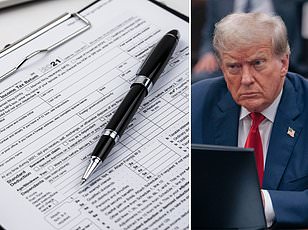Where taxes would rise the most if Trump's tax cuts expire
Trump-era legislation brought in by the Tax Cuts and Jobs Act in 2017 made sweeping changes to the tax landscape.
This included lowering individual income tax rates, almost doubling the standard deduction and raising the federal estate tax exemption.
But these cuts are due to expire at the end of 2025, and most Americans will see their tax bill jump as a result.
Residents of some states will be harder hit than others, according to analysis by nonpartisan think tank the Tax Foundation.
Lawmakers from both parties say they want to avoid increasing these levies. Donald Trump wants to extend the expiring reductions, while the Democrats want to keep cuts for households earning less than $400,000 a year.

Trump-era legislation brought in by the Tax Cuts and Jobs Act in 2017 made sweeping changes to the tax landscape
According to Tax Foundation, taxpayers in Massachusetts will see the biggest rise in their bill in 2026 if the cuts expire and business taxes increase as scheduled - with an average hike of $4,682 a year.
Those living in Washington will see their bill go up an average of $4,429, while an increase of $4,312 will be the norm for taxpayers in Wyoming.
In Washington DC, the average taxpayer will have to fork out $3,746 more a year if the legislation expires as planned.
Across the country, the average taxpayer would see a $2,853 increase if the tax provisions expire all at once, according to the think tank.
Tax Foundation also calculated the typical change in taxes paid per taxpayer across each congressional district in the US.
It found, for example, the congressional district covering the San Francisco area would see an average tax hike of $16,127 per taxpayer - which is the highest in the US.
Expiration would raise taxes more for higher-income households, which can skew the average in some places, The Wall Street Journal reported.
When former President Donald Trump brought in the provisions in 2017, the change in the amount of taxes a household paid depended on its income, family structure and location.
The biggest winners included top earners in states without income taxes, according to the outlet.
Residents of high-tax states such as New York and New Jersey, meanwhile, saw smaller reductions in their taxes due.
If the tax cuts expire, many of those effects would occur in reverse.
For example, many states which do not have an individual income tax - including Wyoming, Nevada and Florida - are among the ten states which will see the highest average hike if the cuts expire.

Trump-era tax cuts are due to expire at the end of 2025, and most Americans will see their bill increase as a result

According to Tax Foundation, taxpayers in Massachusetts will see the biggest rise in their bill in 2026 if the cuts expire - with an average hike of $4,682 a year (Pictured: Boston waterfront)
Full expiration of the law is not a likely outcome, according to The Wall Street Journal, but how the legislation is dealt with is likely to be a contentious multitrillion-dollar negotiation in 2025.
Tax Foundation estimates that extending the individual and business provisions - excluding changes to estate tax - would cost about $3.8 trillion over the 10-year budget window from 2025 through 2034.
As well as extending all the provisions, Trump has also proposed eliminating taxes on tips and Social Security benefits, while also reducing the corporate tax rate from 21 percent to 15 percent.
Vice President Kamala Harris has also proposed eliminating taxes on tips, alongside expanding the child tax credit and leaving the cuts in place for people earning up to $400,000 a year.


































































































































































































